- Home
- Media Kit
- MediaJet
- Current Issue
- Past Issues
- Reprints (PDF)
- Photo Specifications (PDF)
- Contact Us
- PRIVACY POLICY
- TERMS OF USE
![]()
ONLINE
![]()
ONLINE

Purpose And Passion
Editors’ Note
Recently named by Fortune as one of the “World’s 50 Greatest Leaders,” Peter Diamandis is the Founder and Executive Chairman of the XPRIZE Foundation which leads the world in designing and operating large-scale incentive competitions. He is also the Executive Founder of Singularity University, a graduate-level Silicon Valley institution that counsels the world’s leaders on exponentially growing technologies. As an entrepreneur, Diamandis has started over 25 companies in the areas of longevity, space, venture capital, and education. He is the Co-Founder and Vice Chairman of Celularity, Inc., a cellular therapeutics company, and the Co-Founder of BOLD Capital Partners, a venture fund with $250 million investing in exponential technologies. Diamandis is a New York Times Bestselling author of three books: Abundance – The Future Is Better Than You Think; BOLD – How to Go Big, Create Wealth & Impact the World; and The Future is Faster Than You Think. He earned degrees in molecular genetics and aerospace engineering from MIT and holds an MD from Harvard Medical School.
Foundation Brief
XPRIZE (xprize.org) is the recognized global leader in designing and executing large-scale competitions to solve humanity’s greatest challenges. For 30 years, its unique model has democratized crowd-sourced innovation and scientifically scalable solutions that accelerate a more equitable and abundant future.
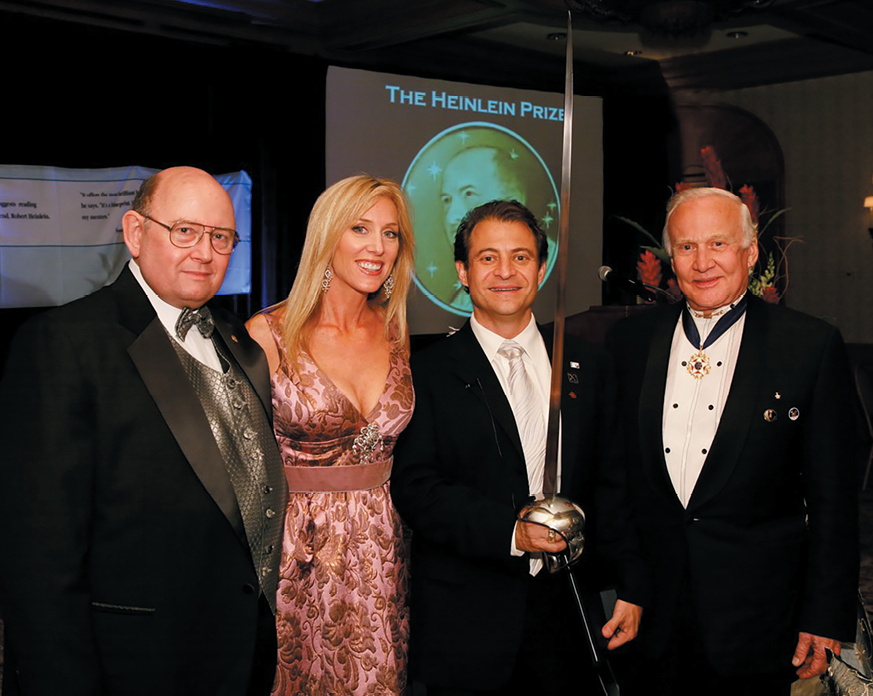
Peter Diamandis at the first Heinlein Prize
with Art Dula, Kristen Diamandis and Buzz Aldrin
Will you discuss your career journey?
When I got to MIT in 1980, I started my first company which was a nonprofit called Students for the Exploration and Development of Space (SEDS), which grew into a national and international organization with close to 100 chapters around the world. Famously, the president of the Princeton chapter was Jeff Bezos. From there, I started Space Generation Foundation with two colleagues that I had met through SEDS, and then the founding conference of the International Space University (ISU) which was on the campus of MIT.
I was in my fourth year of medical school at the time and found myself running ISU with a colleague while also launching a company called International Microspace, which developed low-cost small satellites. I was working during the days at the company, and working nights at the hospital. When I received my medical degree, I sent a copy to my parents and then started putting all my focus into ISU and International Microspace. Fast forward, ISU is still here today and is now based in Strasbourg, France, and is doing extraordinarily well. International Microspace was sold to another company.
I spent the next decade in the space business, starting a company called Zero Gravity Corporation – the first company to offer weightless parabolic flights to the general public in the U.S. It took 11 years for us to finally get FAA approval and everything operational. During this time, the XPRIZE Foundation was created.
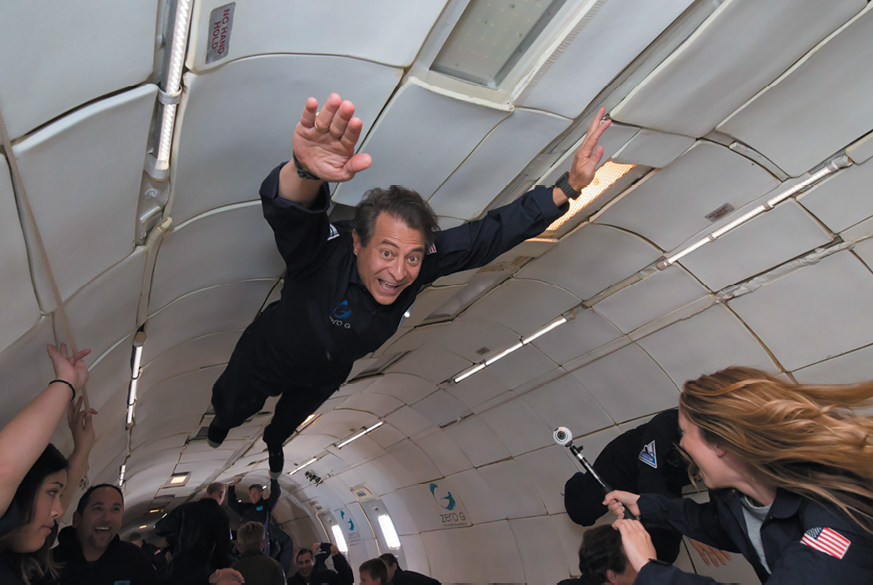
Peter Diamandis flying in Zero G on his plane G-FORCE ONE
At that time of my career, I found myself running a rocket company, a space university, and a nonprofit focused on igniting the space flight revolution. When the first XPRIZE was won for private spaceflight in 2004, I was able to attract some incredible people to the organization – Larry Page came on as a trustee, Elon Musk, and a few others. The organization then decided to pursue multiple prizes and today, 30 years after the founding of XPRIZE in 1994, we have launched thirty XPRIZE’s over 30 years and about $550 million dollars of competitions.
As an optimist with a passion for unleashing human potential, I’ve always had multiple projects on the go at the same time. In addition to being CEO of XPRIZE for the first 20 years and executive chairman for the past 10 years, I founded Singularity University with Ray Kurzweil with a mission to educate, inspire and empower leaders to apply exponential technologies to address humanity’s grand challenges. I also started the Abundance360 program within Singularity University which is a year-round leadership program for exponential entrepreneurs and leaders.
During this time, I also became a writer and have written a number of books, and I am just releasing my new book, Longevity Guidebook, focused on the longevity revolution and how to be a part of it. Over the past 10 years, I have placed a major focus on health and longevity by co-founding a longevity concierge service called Fountain Life with Tony Robbins, Bob Hariri, and Bill Kapp. I believe the longevity industry, together with the AI industry, represent the two most powerful and transformative forces shaping our future today.
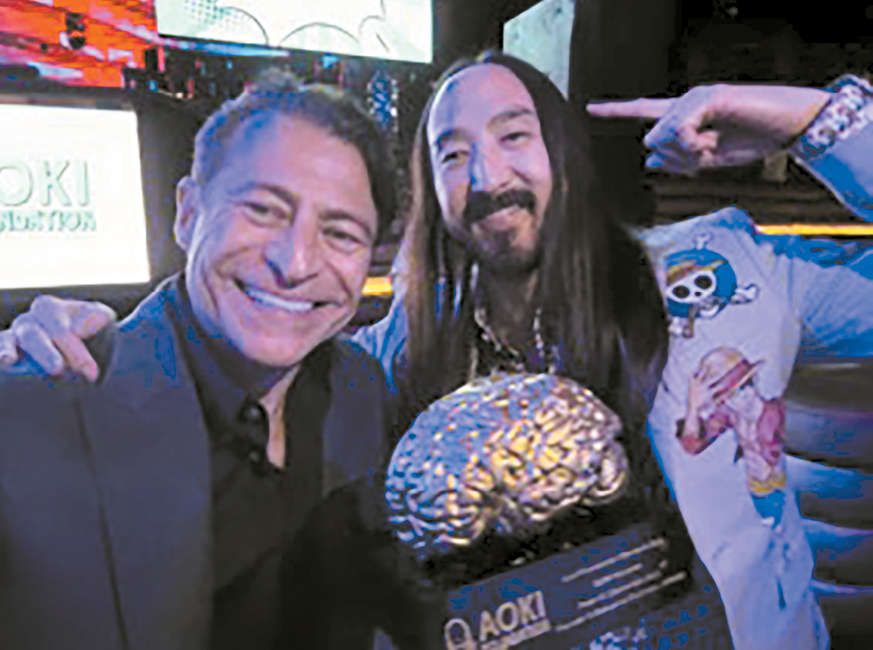
Peter Diamandis being recognized at Aoki Golden Brain Award
with Steve Aoki
How do you describe XPRIZE’s mission and purpose?
XPRIZE’s mission and purpose is to drive disruptive innovation and to solve the world’s biggest challenges. There prizes address a class of grand challenges that are stuck, either because people believe they are not solvable or because they are not being worked on or because the industrial complex doesn’t want to solve it and is happy with the way things are. Our purpose is to be a catalyst for entrepreneurs around the world to attack and solve these problems. We do this by searching for prizable problems – problems with a clear objective and measurable goal that can be described. Money is then raised as an incentive prize, which is awarded to the first person able to demonstrate and accomplish that goal. An example would be wildfires, where we have been fighting fires the same way we have done for the past 50 to 100 years. We created a competition where we asked teams to monitor 1,000 square acres, and if a fire over three meters in size was detected, you need to put it out within 10 minutes. If you are able to do this, you are essentially fighting the fire at inception and before it becomes a wildfire.
We believe the technology is there, and this approach reflects a willingness to get to the root cause across longevity, wildfires, and all these areas of work. It is distinctive. It focuses on doing whatever it takes in the most direct and effective way.
We also just launched XPRIZE Healthspan, a seven-year, $101 million global competition to revolutionize the way we approach human aging. There are more than 400 teams working to demonstrate that their therapeutic treatment restores muscle, cognitive, and immune function by a minimum of 10 years, with a goal of 20 years, in adults aged 50-80 years old. The therapeutic treatment must take one year or less.
So that’s our purpose – to find problems that are stuck, grand challenges that are stuck – and get some of the smartest entrepreneurs on the planet to focus on solving them.
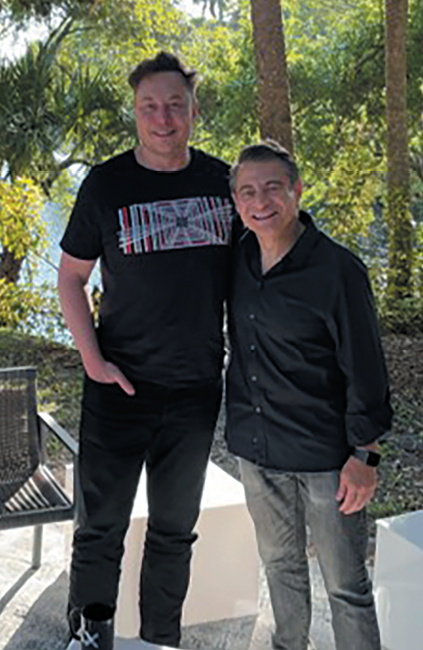
Elon Musk and Peter Diamandis
How important has it been to build the XPRIZE team and to have such an engaged and committed board?
There is nothing you can do today without having a great team, and the XPRIZE board helps underwrite our work and helps connect us with donors. I am so proud to have Anousheh Ansari as CEO of XPRIZE, because she funded our very first prize that ignited a new era for commercial spaceflight. We have about 120 people at XPRIZE in our different domains and support groups from marketing to finance to legal, and they are so committed to our work. They are on a mission, and they’re all mission driven. At the end of the day, the team makes it all happen and none of this would be possible without them.
We have a board of trustees and a board of directors. When I originally built the board of trustees, we had folks like Larry Page, Jim Cameron, Elon Musk, among others, and getting quorum from some 30 trustees was near impossible. Because of this, we shifted more of the fiduciary responsibility to the board of directors and kept the board of trustees as more of an advisory board that meets quarterly and helps make sure we stay on track, that we’re sufficiently audacious, and well capitalized. I am honored to serve as their chairman and to work with Anousheh as CEO.
Where did you develop your passion for the study of longevity and what are you most excited about when you look at this work?
I think my interest in longevity came at three different stages in my life. When I was in medical school in the late 1980s, I distinctly remember one Sunday afternoon watching a documentary on the topic of “long-lived sea life.” It turns out that bowhead whales from the Arctic are able to live for 200 years, and Greenland sharks double that life expectancy with an impressive lifespan of 400 and 500 years. I remember thinking, “If they can live that long, why can’t we?” I figured it was either a software problem or hardware problem, and that we would soon have the ability to solve it. That got me thinking and created my early interest in longevity.
The next thing that really drove me was the fact that progress in space flight was so slow. When I was a kid, the Apollo program was going on, the scientific documentary Star Trek was born, and it showed me what was possible. However, it was moving so slow that I thought that I would need to live another 50 or 100 years to see the future of space that I was so excited about, and it was my desire to participate in the opening of the space frontier.
The third thing is that I realized longevity is one of the biggest business opportunities on the planet – who would not want to add 20 or 30 healthy years in their life?
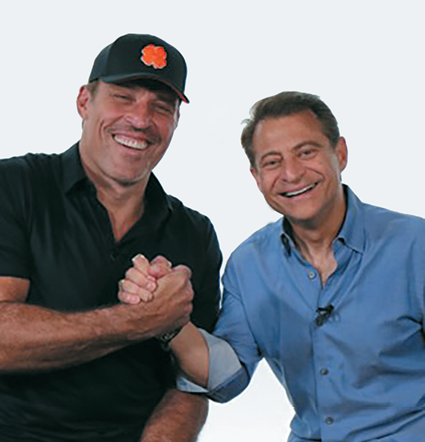
Tony Robbins and Peter Diamandis
Did you always know that you had an entrepreneurial spirit and desire to build your own businesses?
I didn’t know until I got to MIT, and I started SEDS. I was a sophomore, and there was no student space organization on campus, which is why I started the Students for the Exploration and Development of Space. We received hundreds of letters from kids around the world desiring to start chapters, and it grew into a global organization. I think that early success really got me excited about the notion of having an idea and creating something, and it became addictive in that regard.
With all that XPRIZE has accomplished over the past 30 years, are you able to enjoy the process and take moments to celebrate the wins?
That is a great question. I would like to say yes, but I think this is difficult for entrepreneurs since as soon as something is accomplished, your eyes and sights are set on the next thing. Having said that, it is pretty incredible how far XPRIZE has come. From initiating commercial spaceflight, to cleaning up our oceans, and advancing carbon capture solutions, I’m thankful for all that we’ve done and thankful for all who participated so far.
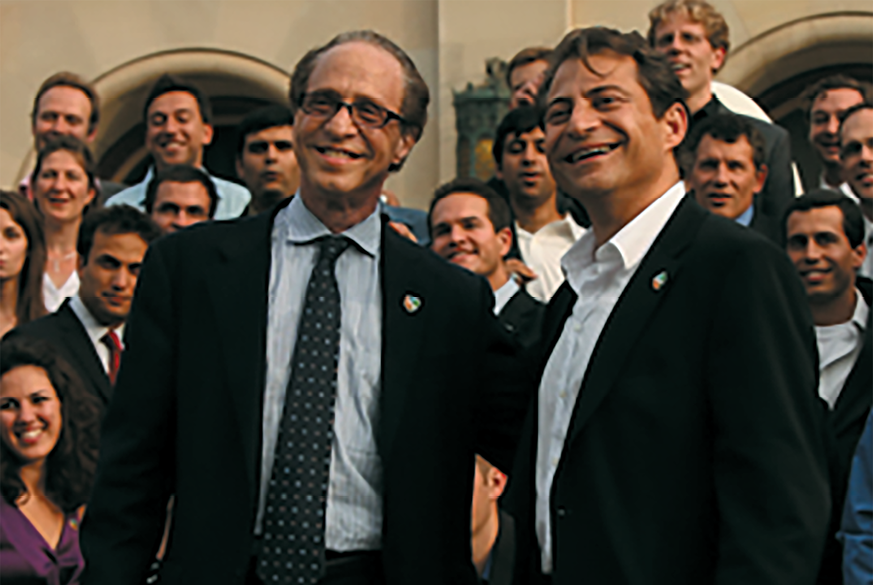
Peter Diamandis with futurist Ray Kurzweil
What are your priorities for XPRIZE as you look to the next 30 years?
When I look at the next 30 years for XPRIZE, I think it is going to be exciting because we are incentivizing small teams to take big risks. These teams now have access to incredible technology, the most powerful technology ever in terms of AI and computation, sensors, networks, 3D printing, synthetic biology, and so much more. All of these technologies will enable small teams to do incredible things. Our objective is to uplift every man, woman, and child, and to create a world of abundance. That is our mission at XPRIZE.
How do we make sure every person on the planet has access to all the food, water, energy, healthcare, education, freedom, communications, knowledge, and intelligence that they need access to? That is what we’re focused on, and I think we can get there. We are also focused on opening the space frontier, exploring the oceans, getting the environment back into a state of stability and vibrancy. That is the next 30 years.
What advice do you offer to young people beginning their careers?
I tell them not to do something just for the money – figure out what your purpose is in life. This is what I call your massive transformative purpose, your MTP. There is a quote from Mark Twain that says, “the two most important days in your life are the day you are born and the day you find out why.” I think it’s important for people to connect with their why. Why are they here? Understanding your purpose and passion in life is one of the most important things that you need to do at the beginning of your career, because doing anything big and bold in the world is hard work.![]()